Basketball Court Lighting Standards and Requirements
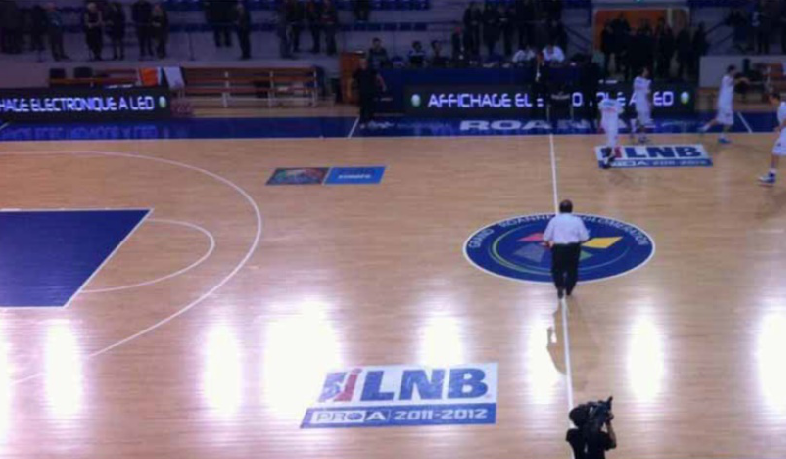
Table of Contents
2. Basketball Court Lighting requirements and recommendations
2.1 Basketball Court Illuminance levels
2.2 Glare towards the main camera
2.5 Basketball Court Light source
1. EC/EV/EH
The vertical illuminance (EC) (illuminance towards the main camera) and (EV) (illumi-nance towards the mobile cameras) are a key parameter for the picture quality. If there are varying levels of vertical illuminance at different positions on the court, then it can be disturbing when panning the camera. It is therefore essential that there is total uniformity in the distribution of the vertical illuminance over the entire court (also called uniformity of the vertical illuminance).
The vertical illuminance shall be kept as constant as possible in the four main direc-tions facing the sides of the court where the cameras are generally located.
The horizontal illuminance (EH) is the quantity of light falling on the court. As the illuminated court is the principal part of the camera’s field of view, the horizontal illuminance shall be as uniform as possible and the ratio between the average horizontal illuminance and the average vertical illuminance towards the main camera shall be kept to a level that ensures a good quality contrast of the pictures.

2. Lighting requirements and recommendations
The Basketball Court Lighting must be designed for television broadcasting while minimising the glare for players and referees.
2.1 Illuminance levels
The court shall be uniformly and adequately lit. The illuminance level must be calculated and shall comply with the values specified in Table 5.
Distinction shall be made between the Principal Playing Area (PPA) which represents the court including the further boundary lane (19 m x 32 m) and the Total Playing Area (TPA) which includes a 1.5 m wide area around the court, including the team benches (22 m x 35 m). Annex 1 shows the grid point to be used for the calculations and the typical camera positions. Average values are maintained values.
No calculations are required for the Beauty Shot camera.

2.2 Glare towards the main camera
The reflections of bright light sources on the court can cause bright spots which will affect the camera picture as illustrated below. Glare caused by high intensity light bouncing off the highly reflective glossy court surfaces towards the main camera position must be avoided especially on all court lines.
Careful attention to the simple necessary geometry will often eliminate these unwanted reflected images (see Annex 2).
2.3 Glare
It is essential that there is no glare whatsoever that affects the view of the basketball players when they are playing. The lighting positions and direction shall be defined in such a way as to take account of the players' view (See Annex 2). The intensity of the light source must be adapted in relation to the installation height.
2.4 Spectator areas
The average illuminance towards the main camera for the first 15 rows of seats shall be between 10 % and 25 % of the average illuminance on the court; the illuminance beyond the first 15 rows shall then uniformly reduce.
2.5 Light source
Flicker Factor, Colour Rendering and Colour Temperature are described below. Each point of the TPA shall meet the requirements stated in Table 6.
The term flicker factor refers to the modulation of luminance on a given plane over a complete cycle. It denotes the relationship between the maximum and minimum illuminance at a point over a period of time (full cycle) and is expressed as a per-centage. This flicker in lighting can negatively affect the quality of broadcasted imagery particularly in instances where slow-motion is utilised. The intensity of discharge lamps (generally used in sports lighting applications) fluctuates if supplied with an electromagnetic gear due to the 50 Hz or 60 Hz supply voltage frequency.
The Colour Rendering Index (CRI) of a light-source is a quantitative value measuring its ability to reveal an objects colour when compared to an ideal or natural light-source. The CRI value is an important factor both for broadcasting quality as well as for venue spectators.
Colour Temperature describes the output of lighting systems in terms of how warm (red) or cool (blue) the light appears. Television broadcasters require a constant colour temperature.

The full court lighting shall be turned on at least 90 minutes prior to the start of the game and maintained until the prescribed requirements for pre-game warm-ups and game play. It shall remain fully lit for at least 30 minutes after the game.
Spotlight introductions for the teams or special ceremonies and entertainment can only be used if the lighting system has instant restrike capabilities which will not alter the light source colour properties.
2.6 Visual Inspection
A visual inspection shall be carried out to evaluate the lighting installation.
No reflected light shall be visible when standing at the main camera position. As TV cameras are more sensitive than the human eye, this can be checked by taking pictures with a digital camera. Attention shall be paid to flood light illuminances wherever they may be located. The players must not be dazzled especially when they are looking at the baskets.
Annex 1 – Grid Point for calculations and typical camera position
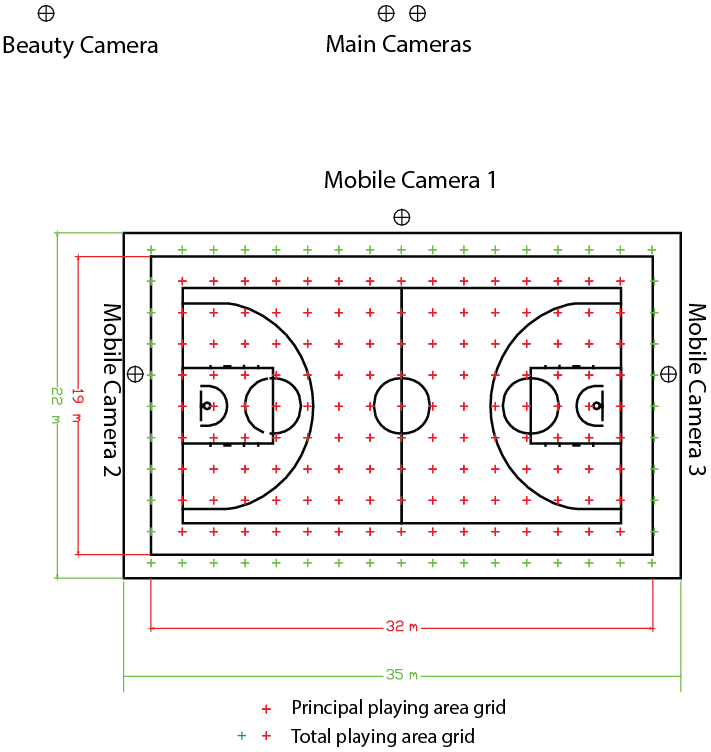
Annex 2 – Recommendation for lighting layout
The location of the flood lights is critical to comply with the lighting requirements. It must ensure that the lighting requirements can be achieved, while not interfering with the players' visibility as well as not creating any glare towards the main camera.
Freedom shall be given to the lighting designer to position the flood lights to provide the best technical solution. It is highly recommended to have a lighting specialist involved in the project from the initial stage.
When the main camera position has been determined, the sources of glare can be minimised by avoiding the installation of flood lights in the forbidden area as shown in the figure below.
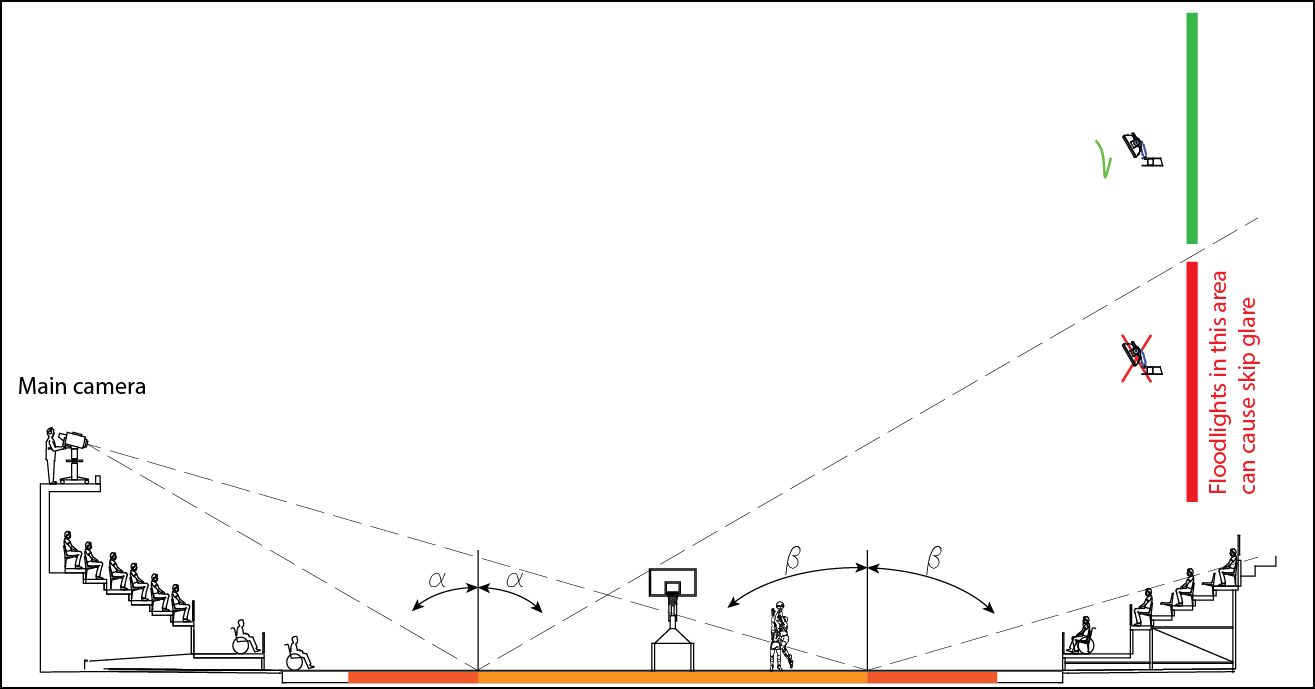
Forbidden area for lighting mountings to avoid glare towards the main camera
The lighting aiming angle (measured from downward vertical) shall ideally be ≤ 60° in order to minimise the glare to the players
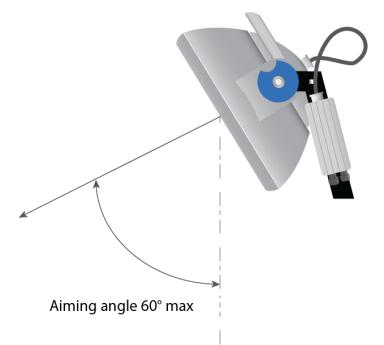
Careful attention shall be paid to the flood light positioning with regards to their aiming directions which shall not interfere with the players vision, especially when they are shooting at the baskets.
The following example illustrates a critical location for flood lights. In this example, the flood lights located in the 20° area shall not be aimed directly towards any player in a shooting position.
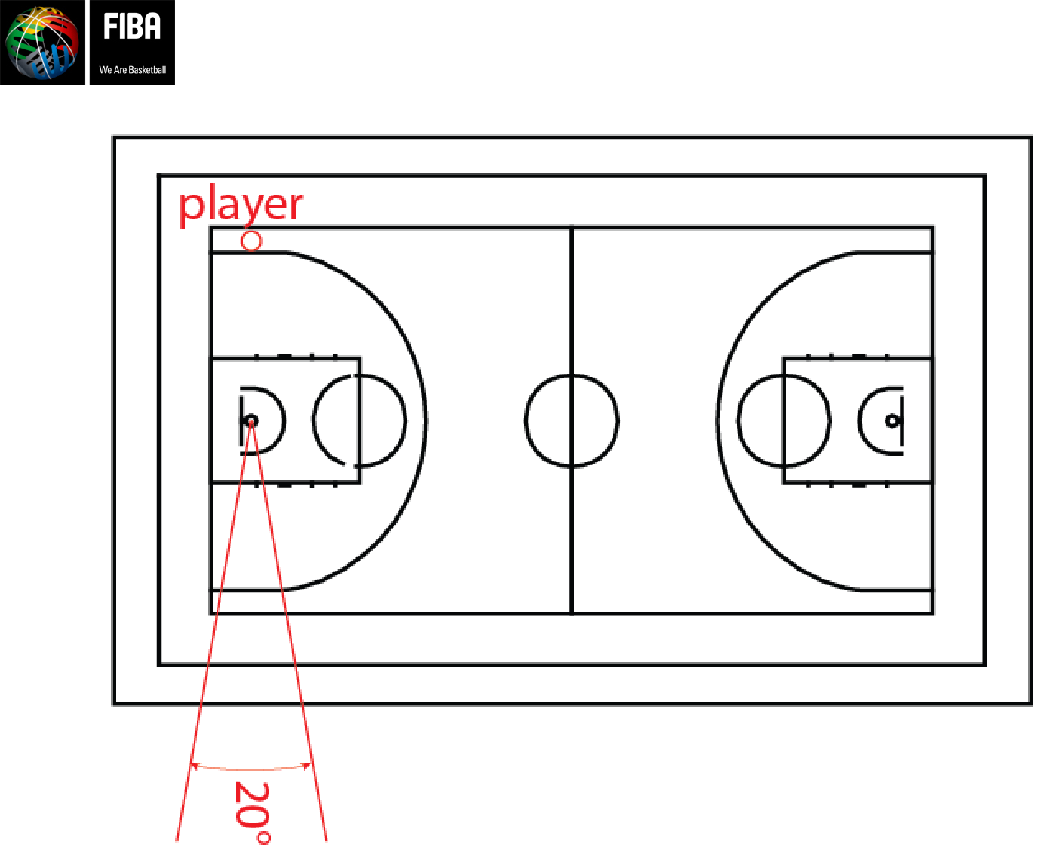
_thumb.jpg)